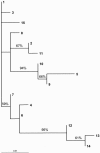Sequence variation of the SeM gene of Streptococcus equi allows discrimination of the source of strangles outbreaks
- PMID: 16455902
- PMCID: PMC1392674
- DOI: 10.1128/JCM.44.2.480-486.2006
Sequence variation of the SeM gene of Streptococcus equi allows discrimination of the source of strangles outbreaks
Abstract
Improved understanding of the epidemiology of Streptococcus equi transmission requires sensitive and portable subtyping methods that can rationally discriminate between strains. S. equi is highly homogeneous and cannot be distinguished by multilocus enzyme electrophoretic or multilocus sequence-typing methods that utilize housekeeping genes. However, on sequence analysis of the N-terminal region of the SeM genes of 60 S. equi isolates from 27 strangles outbreaks, we identified 21 DNA codon changes. These resulted in the nonsynonymous substitution of 18 amino acids and allowed the assignment of S. equi strains to 15 distinct subtypes. Our data suggest the presence of multiple epitopes across this region that are subjected to selective immune pressure (nonsynonymous-synonymous substitution rate [d(N)/d(S)] ratio = 3.054), particularly during the establishment of long-term S. equi infection. We further report the application of SeM gene subtyping as a method to investigate potential cases of disease related to administration of a live attenuated S. equi vaccine. SeM gene subtyping successfully differentiated between the vaccine strain and field strains of S. equi responsible for concurrent disease. These results were confirmed by the development and application of a PCR diagnostic test, which identifies the aroA partial gene deletion present in the Equilis StrepE vaccine strain. Although the vaccine strain was found to be responsible for injection site lesions, all seven outbreaks of strangles investigated in recently vaccinated horses were found to be due to concurrent infection with wild-type S. equi and not due to reversion of the vaccine strain.
Figures



Similar articles
-
Novel Streptococcus equi strains causing strangles outbreaks in Arabian horses in Egypt.Transbound Emerg Dis. 2020 Nov;67(6):2455-2466. doi: 10.1111/tbed.13584. Epub 2020 May 10. Transbound Emerg Dis. 2020. PMID: 32304282
-
Tracing outbreaks of Streptococcus equi infection (strangles) in horses using sequence variation in the seM gene and pulsed-field gel electrophoresis.Vet Microbiol. 2011 Nov 21;153(1-2):144-9. doi: 10.1016/j.vetmic.2011.03.027. Epub 2011 Mar 30. Vet Microbiol. 2011. PMID: 21511406
-
Vaccination with a live multi-gene deletion strain protects horses against virulent challenge with Streptococcus equi.Vaccine. 2015 Feb 25;33(9):1160-7. doi: 10.1016/j.vaccine.2015.01.019. Epub 2015 Jan 15. Vaccine. 2015. PMID: 25597942
-
Getting a grip on strangles: recent progress towards improved diagnostics and vaccines.Vet J. 2007 May;173(3):492-501. doi: 10.1016/j.tvjl.2006.05.011. Epub 2006 Jul 3. Vet J. 2007. PMID: 16820310 Review.
-
Strangles in equines: An overview.Microb Pathog. 2023 May;178:106070. doi: 10.1016/j.micpath.2023.106070. Epub 2023 Mar 15. Microb Pathog. 2023. PMID: 36924902 Review.
Cited by
-
Getting to grips with strangles: an effective multi-component recombinant vaccine for the protection of horses from Streptococcus equi infection.PLoS Pathog. 2009 Sep;5(9):e1000584. doi: 10.1371/journal.ppat.1000584. Epub 2009 Sep 18. PLoS Pathog. 2009. PMID: 19763180 Free PMC article.
-
Globetrotting strangles: the unbridled national and international transmission of Streptococcus equi between horses.Microb Genom. 2021 Mar;7(3):mgen000528. doi: 10.1099/mgen.0.000528. Epub 2021 Mar 8. Microb Genom. 2021. PMID: 33684029 Free PMC article.
-
Lineages of Streptococcus equi ssp. equi in the Irish equine industry.Ir Vet J. 2013 Jun 4;66(1):10. doi: 10.1186/2046-0481-66-10. eCollection 2013. Ir Vet J. 2013. PMID: 23731628 Free PMC article.
-
Current status of veterinary vaccines.Clin Microbiol Rev. 2007 Jul;20(3):489-510, table of contents. doi: 10.1128/CMR.00005-07. Clin Microbiol Rev. 2007. PMID: 17630337 Free PMC article. Review.
-
Streptococcus equi subspecies equi in horses in Israel: seroprevalence and strain types.Vet Rec Open. 2016 Aug 16;3(1):e000187. doi: 10.1136/vetreco-2016-000187. eCollection 2016. Vet Rec Open. 2016. PMID: 27651915 Free PMC article.
References
-
- Al-Ghamdi, G. M., V. Kapur, T. R. Ames, J. F. Timoney, D. N. Love, and M. A. Mellencamp. 2000. Use of repetitive sequence-based polymerase chain reaction for molecular epidemiologic analysis of Streptococcus equi subspecies equi. Am. J. Vet. Res. 61:699-705. - PubMed
-
- Chanter, N., N. C. Talbot, J. R. Newton, D. Hewson, and K. Verheyen. 2000. Streptococcus equi with truncated M-proteins isolated from outwardly healthy horses. Microbiology 146:1361-1369. - PubMed
MeSH terms
Substances
LinkOut - more resources
Full Text Sources
Other Literature Sources
Medical

